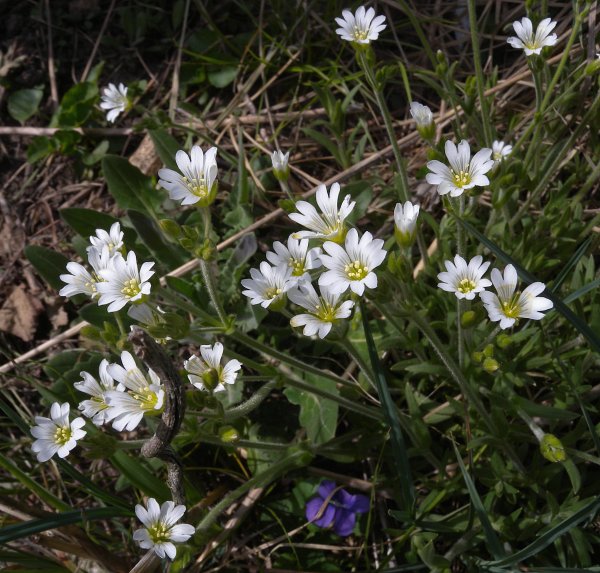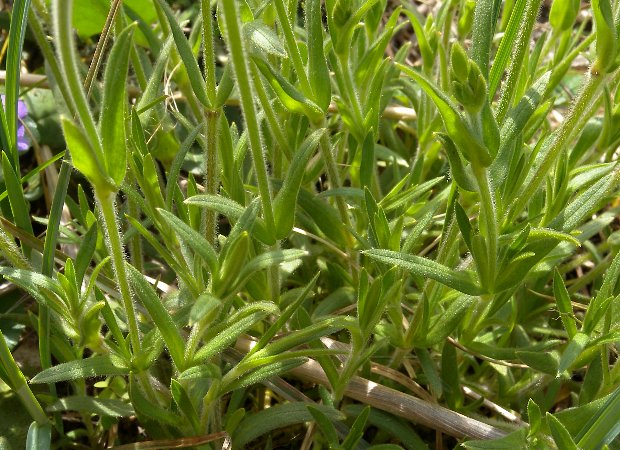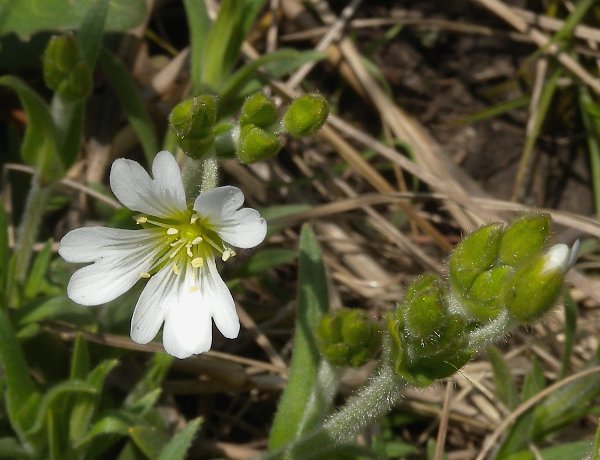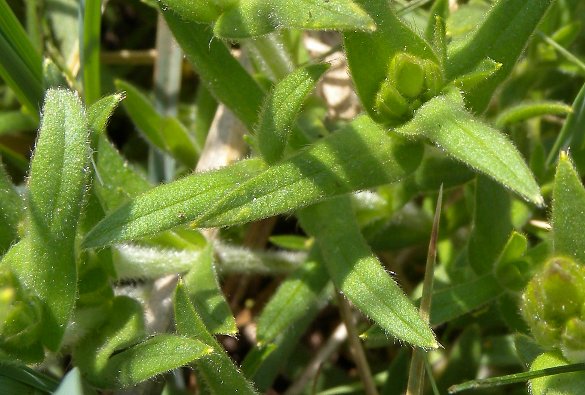Field
Chickweed
Cerastium arvense strictum
Pink family (Caryophyllaceae)
Cerastium arvense strictum
Pink family (Caryophyllaceae)
Description:
This herbaceous perennial plant is 3–10" tall, forming leafy stems that
often branch near the base. During the early stages of development in
the spring, the foliage often has a matted appearance. Individual stems
are light green, terete, and pubescent (sometimes becoming
glandular-pubescent above). Pairs of opposite leaves occur along these
stems; there are more pairs of leaves below than above. These leaves
are usually ascending and slightly recurved. Individual leaves are ¼–1¼"
(6–30 mm.) long and 1.5–6 mm. (up to ¼") across; they are narrowly
lanceolate to lanceolate, narrowly oblanceolate, or linear-oblong in shape with margins
that are toothless and ciliate. These leaves are sessile or they
slightly clasp the stems. The upper and lower leaf surfaces are medium
green and usually sparsely pubescent; there tends to be more hairs
along the lower side of the central vein of the leaves and along the
margins. Small tufts of secondary leaves often develop from the axils
of the lower leaves; these secondary leaves are similar to the primary
leaves, except they are shorter and more narrow. The upper stems
terminate in cymes or flat-headed panicles of flowers; usually only a
few flowers are in bloom at the same time in each inflorescence.
Individual flowers span about 1/3" (8 mm.) across (sometimes slightly
more), consisting of 5 white petals, 5 light green sepals, 10 stamens
with pale yellow anthers, and a yellowish green pistil with 5 styles.
On uncommon occasions, a flower will have 4 petals, 4 sepals, and 8
stamens.

Individual petals are ascending and recurved; they are narrowly obcordate in shape with 2 rounded lobes (uncommonly with 3 rounded lobes) and there are fine translucent veins that radiate from the center of the flower. These veins are primarily straight, although they branch occasionally. The sepals are lanceolate in shape and pubescent to glandular-pubescent; they are about one-half to two-thirds of the length of the petals. At the base of each inflorescence, there is a pair of small leafy bracts that are lanceolate to ovate in shape; they are similar to the leaves. The branches of the inflorescence and the pedicels of the flowers are similar to the stems, except they are more likely to be glandular-pubescent. Individual pedicels are ¼–1¼" (6-30 mm.) long. The blooming period occurs from mid- to late-spring, lasting about 1 month. Afterwards, the flowers are replaced by seed capsules. These seed capsules are about 8–11 mm. (1/3" or slightly more) in length, narrowly cylindrical in shape, and usually curved slightly to one side. At the apex of each capsule, there are 10 tiny teeth. The capsules become light tan at maturity, at which time the flowering leafy stems die down. Each capsule contains several tiny seeds. Individual seeds are 0.5–1.2 mm. across, somewhat flattened, and tuberculate across the surface. The root system consists of a taproot, later developing short-rhizomes.

Cultivation: The preference is full or partial sun, mesic to dry conditions, cool temperatures, and a barren calcareous soil containing sand or rocky material. This plant can also be cultivated in gardens in loamy soil. Most growth and development occurs during the spring. Low leafy stems that are sterile may persist during the summer, autumn, and winter if there is enough moisture.
Range & Habitat: This subspecies of Field Chickweed (Cerastium arvense strictum) is native to Illinois, occurring as an occasional plant in NE Illinois and an uncommon plant in scattered counties in the southern half of Illinois (see Distribution Map). It is widely distributed in North America, especially in boreal areas. Habitats include gravel hill prairies, sand prairies, sand dunes, alvars (north of Illinois), openings in rocky upland woodlands, sandstone and limestone cliffs, grassy meadows, and abandoned fields. This plant is found in both higher quality natural areas and disturbed areas.

Faunal Associations: The nectar and pollen of the flowers attract primarily bees, including little carpenter bees (Ceratina spp.), cuckoo bees (Nomada spp.), mason bees (Osmia spp.), Halictid bees (Lasioglossum spp.), and Andrenid bees (Andrena spp.); see Steury et al. (2009). Some insects feed destructively on Field Chickweed and other mouse-eared chickweeds (Cerastium spp.). This includes larvae of such moths as Haematopis grataria (Chickweed Geometer), Heliothis borealis (Boreal Gem), and Hadena capsularis (Capsule Moth); the larvae of these moths feed on the flowers and developing seeds (Natural History Museum website, accessed 2010). Other insect feeders include Melanoplus borealis (Boreal Grasshopper) and Aphis sambuci (Elder Aphid); see Wyoming Agr. Exp. Sta. (1994) and Blackman & Eastop (2013). The seeds of chickweeds are eaten by many small rodents, including the Deer Mouse, Meadow Jumping Mouse, House Mouse, and Thirteen-lined Ground Squirrel (Houtcooper, 1978; Whitaker & Mumford, 1970; Whitaker, 1972). The Field Sparrow and probably other granivorous songbirds also eat the seeds occasionally (DeVore et al., 2004).

Discussion: Field Chickweed is the most attractive mouse-eared chickweed in Illinois (Cerastium) because it has the largest flowers. Being a perennial plant, rather than an annual plant (like most chickweeds), it is also easier to sustain in the garden. Field Chickweed (Cerastium arvense) has a history of taxonomic instability because of its variable characteristics across its range in North America and Europe. Two other subspecies of Field Chickweed include Cerastium arvense arvense (native to Europe, introduced into North America) and Cerastium arvense velutinum (native to North America, including Illinois). These latter two subspecies can be distinguished from Cerastium arvense strictum by their ranker growth (stems often exceeding 10" in length), larger flowers (about ½" across), and long rhizomes.

Individual petals are ascending and recurved; they are narrowly obcordate in shape with 2 rounded lobes (uncommonly with 3 rounded lobes) and there are fine translucent veins that radiate from the center of the flower. These veins are primarily straight, although they branch occasionally. The sepals are lanceolate in shape and pubescent to glandular-pubescent; they are about one-half to two-thirds of the length of the petals. At the base of each inflorescence, there is a pair of small leafy bracts that are lanceolate to ovate in shape; they are similar to the leaves. The branches of the inflorescence and the pedicels of the flowers are similar to the stems, except they are more likely to be glandular-pubescent. Individual pedicels are ¼–1¼" (6-30 mm.) long. The blooming period occurs from mid- to late-spring, lasting about 1 month. Afterwards, the flowers are replaced by seed capsules. These seed capsules are about 8–11 mm. (1/3" or slightly more) in length, narrowly cylindrical in shape, and usually curved slightly to one side. At the apex of each capsule, there are 10 tiny teeth. The capsules become light tan at maturity, at which time the flowering leafy stems die down. Each capsule contains several tiny seeds. Individual seeds are 0.5–1.2 mm. across, somewhat flattened, and tuberculate across the surface. The root system consists of a taproot, later developing short-rhizomes.

Cultivation: The preference is full or partial sun, mesic to dry conditions, cool temperatures, and a barren calcareous soil containing sand or rocky material. This plant can also be cultivated in gardens in loamy soil. Most growth and development occurs during the spring. Low leafy stems that are sterile may persist during the summer, autumn, and winter if there is enough moisture.
Range & Habitat: This subspecies of Field Chickweed (Cerastium arvense strictum) is native to Illinois, occurring as an occasional plant in NE Illinois and an uncommon plant in scattered counties in the southern half of Illinois (see Distribution Map). It is widely distributed in North America, especially in boreal areas. Habitats include gravel hill prairies, sand prairies, sand dunes, alvars (north of Illinois), openings in rocky upland woodlands, sandstone and limestone cliffs, grassy meadows, and abandoned fields. This plant is found in both higher quality natural areas and disturbed areas.

Faunal Associations: The nectar and pollen of the flowers attract primarily bees, including little carpenter bees (Ceratina spp.), cuckoo bees (Nomada spp.), mason bees (Osmia spp.), Halictid bees (Lasioglossum spp.), and Andrenid bees (Andrena spp.); see Steury et al. (2009). Some insects feed destructively on Field Chickweed and other mouse-eared chickweeds (Cerastium spp.). This includes larvae of such moths as Haematopis grataria (Chickweed Geometer), Heliothis borealis (Boreal Gem), and Hadena capsularis (Capsule Moth); the larvae of these moths feed on the flowers and developing seeds (Natural History Museum website, accessed 2010). Other insect feeders include Melanoplus borealis (Boreal Grasshopper) and Aphis sambuci (Elder Aphid); see Wyoming Agr. Exp. Sta. (1994) and Blackman & Eastop (2013). The seeds of chickweeds are eaten by many small rodents, including the Deer Mouse, Meadow Jumping Mouse, House Mouse, and Thirteen-lined Ground Squirrel (Houtcooper, 1978; Whitaker & Mumford, 1970; Whitaker, 1972). The Field Sparrow and probably other granivorous songbirds also eat the seeds occasionally (DeVore et al., 2004).

Discussion: Field Chickweed is the most attractive mouse-eared chickweed in Illinois (Cerastium) because it has the largest flowers. Being a perennial plant, rather than an annual plant (like most chickweeds), it is also easier to sustain in the garden. Field Chickweed (Cerastium arvense) has a history of taxonomic instability because of its variable characteristics across its range in North America and Europe. Two other subspecies of Field Chickweed include Cerastium arvense arvense (native to Europe, introduced into North America) and Cerastium arvense velutinum (native to North America, including Illinois). These latter two subspecies can be distinguished from Cerastium arvense strictum by their ranker growth (stems often exceeding 10" in length), larger flowers (about ½" across), and long rhizomes.